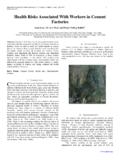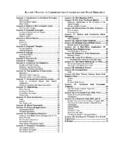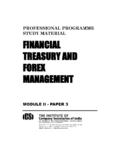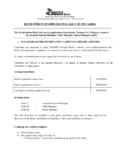Transcription of The Effect of Foreign Exchange Exposure on the …
1 International Journal of Scientific and Research Publications, Volume 5, Issue 11, November 2015 115 ISSN 2250-3153 The Effect of Foreign Exchange Exposure on the Financial Performance of Commercial Banks in Kenya Leyla Ahmed College of Human Resource development, Jomo Kenyatta University of Agriculture & Technology Abstract- Exchange rate movement in Kenya has been variable with periods of rapid depreciation of the domestic currency Kenya Shilling, which adversely affect the Kenyan economy. Even though studies have been conducted on the Exchange rate regimes and the implications for macroeconomic management as well as managing Foreign Exchange risk, very little has been done on the study of the firm Exposure to Exchange risk in Kenya. It is in this context that this research was to evaluate the effects (if any) that variations in the Exchange rate has in the financial performance of the selected listed commercial banks in Kenya in the Nairobi Stock Exchange .
2 The overall objective of the study is to find out the Effect of Foreign Exchange Exposure on commercial bank performance. The research used both secondary and primary data. The study utilized descriptive design. Data was analysed using Statistical Package for Social Sciences (SPSS). The study found that first; interest rates have an insignificant positive Effect on commercial bank performance, secondly, Foreign Exchange Exposure has negative Effect on the performance of listed commercial banks in Kenya and finally, inflation has negative Effect on bank performance. The study recommended that regulators who include Central Bank of Kenya to manage the interest rates in the country so as to ensure stable Exchange rate environment and the management of commercial banks in Kenya to continue improving the Foreign Exchange Exposure management techniques.
3 Index Terms- KES; The Kenya Shilling is the official currency of Kenya. Euro; The name for the composite monetary unit of the European Union that has replaced national currencies in several European countries (Euro zone). It was launched in 1999 as Europe s single currency now shared by 17 EU countries and around 331 million citizens. Member states are Belgium, Germany, Estonia, Ireland, Greece, Spain, France, Italy, Cyprus, Luxembourg, Malta, Netherlands, Austria, Portugal, Slovenia, Slovakia and Finland. Non-participants are Bulgaria, Czech Republic, Denmark, Latvia, Lithuania, Hungary, Poland, Romania, Sweden and the United Kingdom are EU Member States but do not currently use the single European currency. Financial risk; Financial risk refers to unexpected events in a country s financial, economic, or business life. Foreign Exchange (FX); The Exchange of one currency for another or the conversion of one currency into another currency.
4 Foreign Exchange also refers to the global market where currencies are traded virtually around-the-clock. The term Foreign Exchange is usually abbreviated as "forex" and occasionally as "FX." Foreign Exchange rate; The rate or price of the currency of one country in terms of the currency of another for example, the value of British pounds expressed in dollars. GBP; The Great Britain Pound or the Sterling Pound is the currency used by the countries ofthe United Kingdom consisting of England, Northern Ireland, Scotland and Wales. JPY (100); The Japanese Yen expressed in 100 Kes is the official currency of Japan. It is the third most-traded currency in the Foreign Exchange market after the United States dollar and the Euro. USD; United States Dollar is the official currency of the United States of America. I. INTRODUCTION ost international business results in the Exchange of one currency for another to make payment.
5 Since Exchange rate fluctuates on daily basis, the cash outflows required to make payments change accordingly. Consequently the number of unit of a firm home currency needed to purchase Foreign supplies can change even if the suppliers have not adjusted their prices. Exchange rate risk can be broadly defined as the risk that a company performance will be affected by Exchange rate movements. Financial managers must understand how to measure the Exposure to Exchange rate fluctuations so that they can determine whether and how to protect their company from such Exposure . Foreign Exchange Exposure refers to the sensitivity of a firms cash flows, real domestic currency value of assets, liabilities, or operating incomes to unanticipated changes in Exchange rates. Foreign Exchange rate movements could be an important source of risk for banking institutions.
6 In the worst case, large Foreign Exchange losses could lead to bank failures. Even for a mild scenario, Foreign Exchange losses could cause huge burdens on banks profitability. Due to their serious implications for risk management and banking sector stability, measuring banks Foreign Exchange Exposure has long been a core interest of risk management professionals, academics, and central banks. Empirical evidence suggests that there is a positive relationship between bank size and Foreign - Exchange Exposure . This may be partly due to the fact that larger banks tend to have more significant Foreign - Exchange operations and trading positions. Larger banks may also have more businesses with large and international corporations, of which competitiveness and profitability are sensitive to Exchange -rate movements. These may contribute to the more significant Foreign - Exchange Exposure of larger Kenyan banks.
7 M International Journal of Scientific and Research Publications, Volume 5, Issue 11, November 2015 116 ISSN 2250-3153 In addition, the average Foreign - Exchange exposures of commercial banks in Kenya are high. This may reflect the lack of financial instruments available for Kenya banks to hedge their Foreign - Exchange risk, or that the banks are less experienced in managing Foreign - Exchange risk. However, partly due to the lack of data, past analyses on the Foreign Exchange Exposure of Commercial banks are rather primitive which mainly focused on the quantification of Foreign Exchange Exposure arising from the banks unhedged Foreign assets and liabilities ( direct or transaction exposures). A bank s loan to an exporter as an example demonstrate that banks that perfectly hedge their accounting Exposure could still be exposed to significant Foreign Exchange risk if Exchange rate movements affect cash flows, competitiveness, and credit risk of banks customers significantly( indirect or economic exposures).
8 This indicates that the sources of Foreign Exchange risk of banks are far more than just their holdings of net Foreign assets. It is also found that Foreign - Exchange Exposure tends to be different among banks, with negative Foreign - Exchange Exposure more prevalent for larger banks, suggesting that an appreciation of the kes tends to reduce their equity values. Since larger banks constitute a major portion of assets in the banking sector, this empirical result suggests that an appreciation of the kes is likely to hamper the banking sector s performance. Together with the fact that decreases in equity values generally imply higher default risk, how banks would be affected under different scenarios of kes appreciation should be closely monitored. Like many firms, banks can be affected by Exchange rate fluctuations. Exchange rates affect most directly those banks with Foreign currency transactions and Foreign operations.
9 Even without such activities, Exchange rates can affect banks indirectly through their influence on the extent of Foreign competition, the demand for loans, and other aspects of banking conditions. II. NATURE AND MEASUREMENT OF Foreign Exchange RISKS The importance of Foreign Exchange Exposure increased shortly after 1973 as the world moved towards a flexible Exchange rate system. While banks faced currency risks prior to that time as there were significant deviations from purchasing power parity, Foreign Exchange risk became explicitly and nominally much more important after 1973. Exposure to Foreign risk can arise when the domestic currency values of assets, liabilities and cash flows denominated in a Foreign currency are subject to change due to Exchange rate changes. Under the perfect market conditions and if parity conditions in the Foreign Exchange market (purchasing power and interest rate) hold, changes in the domestic currency values of Foreign assets, liabilities and cash flows should offset changes in Exchange rates so that there would be no Foreign Exchange Exposure .
10 Because of market frictions and deviations from rational expectations, most commercial banks face significant Exposure to Exchange rate changes. Four Methods To Translate Foreign Currency To Home Currency Current/Non-Current Method: All current assets and current liabilities are translated at current Exchange rates. Monetary/Non-Monetary Method: All monetary assets and liabilities are translated at current Exchange rates. Temporal Method: Same as monetary/non-monetary method but inventory may be translated at current Exchange rate if it is shown at market value. Current Rate Method: All balance sheet and income statement items are translated at current Exchange rate. Classification Of Forex Exposures And Averting Strategies Financial economists distinguish between three types of currency exposures- transaction exposures, translation exposures and economic exposures.















